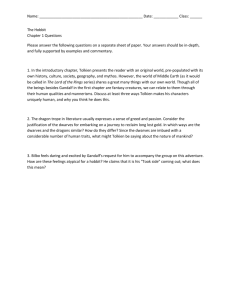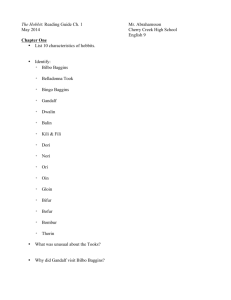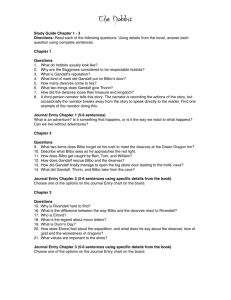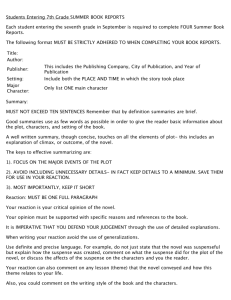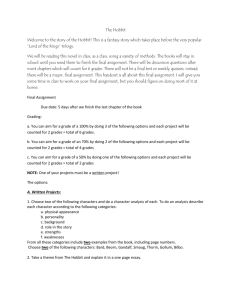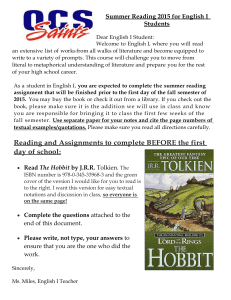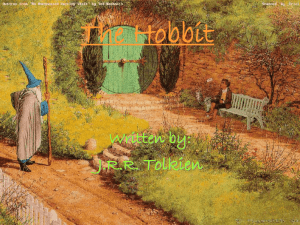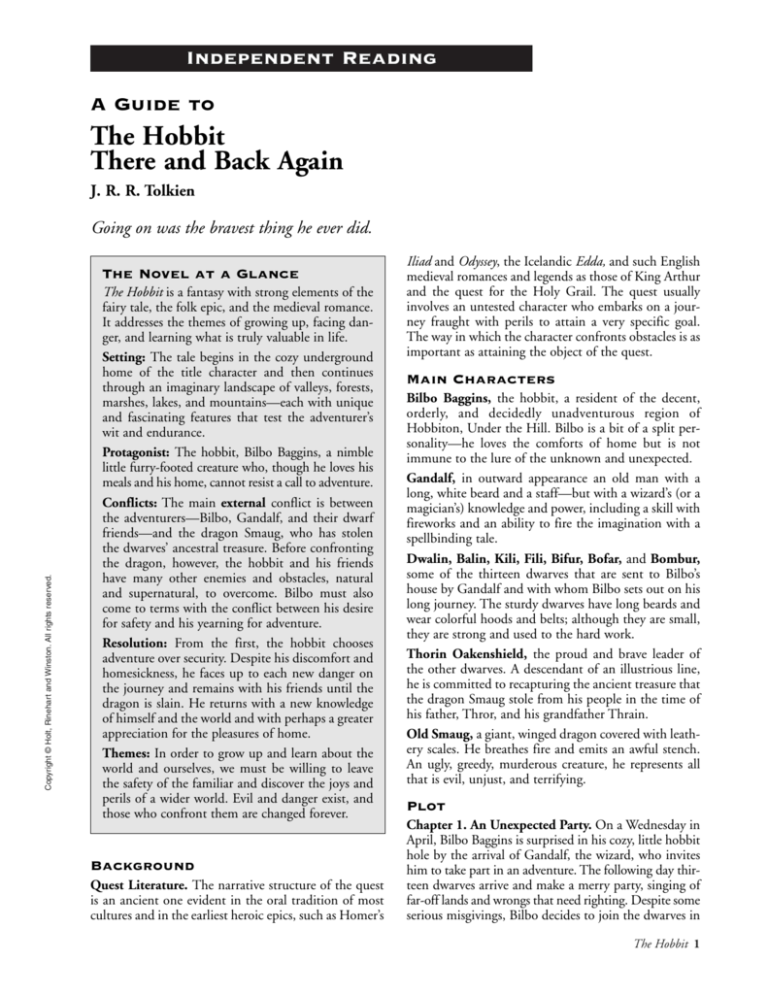
Independent Reading
A Guide to
The Hobbit
There and Back Again
J. R. R. Tolkien
Going on was the bravest thing he ever did.
Copyright © Holt, Rinehart and Winston. All rights reserved.
The Novel at a Glance
The Hobbit is a fantasy with strong elements of the
fairy tale, the folk epic, and the medieval romance.
It addresses the themes of growing up, facing danger, and learning what is truly valuable in life.
Setting: The tale begins in the cozy underground
home of the title character and then continues
through an imaginary landscape of valleys, forests,
marshes, lakes, and mountains—each with unique
and fascinating features that test the adventurer’s
wit and endurance.
Protagonist: The hobbit, Bilbo Baggins, a nimble
little furry-footed creature who, though he loves his
meals and his home, cannot resist a call to adventure.
Conflicts: The main external conflict is between
the adventurers—Bilbo, Gandalf, and their dwarf
friends—and the dragon Smaug, who has stolen
the dwarves’ ancestral treasure. Before confronting
the dragon, however, the hobbit and his friends
have many other enemies and obstacles, natural
and supernatural, to overcome. Bilbo must also
come to terms with the conflict between his desire
for safety and his yearning for adventure.
Resolution: From the first, the hobbit chooses
adventure over security. Despite his discomfort and
homesickness, he faces up to each new danger on
the journey and remains with his friends until the
dragon is slain. He returns with a new knowledge
of himself and the world and with perhaps a greater
appreciation for the pleasures of home.
Themes: In order to grow up and learn about the
world and ourselves, we must be willing to leave
the safety of the familiar and discover the joys and
perils of a wider world. Evil and danger exist, and
those who confront them are changed forever.
Background
Quest Literature. The narrative structure of the quest
is an ancient one evident in the oral tradition of most
cultures and in the earliest heroic epics, such as Homer’s
Iliad and Odyssey, the Icelandic Edda, and such English
medieval romances and legends as those of King Arthur
and the quest for the Holy Grail. The quest usually
involves an untested character who embarks on a journey fraught with perils to attain a very specific goal.
The way in which the character confronts obstacles is as
important as attaining the object of the quest.
Main Characters
Bilbo Baggins, the hobbit, a resident of the decent,
orderly, and decidedly unadventurous region of
Hobbiton, Under the Hill. Bilbo is a bit of a split personality—he loves the comforts of home but is not
immune to the lure of the unknown and unexpected.
Gandalf, in outward appearance an old man with a
long, white beard and a staff—but with a wizard’s (or a
magician’s) knowledge and power, including a skill with
fireworks and an ability to fire the imagination with a
spellbinding tale.
Dwalin, Balin, Kili, Fili, Bifur, Bofar, and Bombur,
some of the thirteen dwarves that are sent to Bilbo’s
house by Gandalf and with whom Bilbo sets out on his
long journey. The sturdy dwarves have long beards and
wear colorful hoods and belts; although they are small,
they are strong and used to the hard work.
Thorin Oakenshield, the proud and brave leader of
the other dwarves. A descendant of an illustrious line,
he is committed to recapturing the ancient treasure that
the dragon Smaug stole from his people in the time of
his father, Thror, and his grandfather Thrain.
Old Smaug, a giant, winged dragon covered with leathery scales. He breathes fire and emits an awful stench.
An ugly, greedy, murderous creature, he represents all
that is evil, unjust, and terrifying.
Plot
Chapter 1. An Unexpected Party. On a Wednesday in
April, Bilbo Baggins is surprised in his cozy, little hobbit
hole by the arrival of Gandalf, the wizard, who invites
him to take part in an adventure. The following day thirteen dwarves arrive and make a merry party, singing of
far-off lands and wrongs that need righting. Despite some
serious misgivings, Bilbo decides to join the dwarves in
The Hobbit 1
2 The Hobbit
Chapter 6. Out of the Frying-Pan and into the Fire.
In the open air, Bilbo realizes he has come out clear on
the other side of the mountain. He discovers that his
friends too are outside the mountain. Bilbo tells about
his encounter with Gollum but leaves out the part about
the ring. The party moves on, the goblins still in pursuit.
As the moon rises they come to a clearing and are forced
to climb trees to escape howling, ravenous wolves
(Wargs). Gandalf rains burning pine cones down on the
wolves, but the goblins arrive and stoke the fires under
the trees where the dwarves are pinned. Just as the smoke
begins to choke them, the Great Eagles of the North
swoop down and carry Bilbo and his friends to safety.
Chapter 7. Queer Lodgings. Bilbo and his party are set
down on a rock ledge. To their dismay, Gandalf
announces he will soon leave them. He then takes them
to the wooden house of the “skin-changer” Beorn, who
can take the form of a huge hairy man or a great bear.
Careful not to upset the unsociable Beorn, Gandalf
introduces the travelers gradually until all fourteen are
sitting on Beorn’s porch and he has heard the complete
story of their adventures. Captivated by the tale, Beorn
offers the hungry band a sumptuous meal. The skinchanger describes the perils of the path through the great,
dark forest of Mirkwood, which Bilbo and the dwarves
must travel to reach the dragon’s stronghold in Lonely
Mountain. Generously outfitting the party for their journey, Beorn warns them to stay on the path at all costs. At
the edge of the dark and ominous forest, Gandalf leaves
the group.
Chapter 8. Flies and Spiders. Picking their way
through the dense forest, Bilbo and the dwarves are surrounded by the glowing eyes of insects and are brushed
by spiders, moths, and bats. Desperate and hungry,
they ignore Beorn’s warning and stray from the path to
investigate glowing fires and the sound of elfish singing.
Three times they approach the campfires and each time
the lights go out. Becoming separated from the others,
Bilbo uses his sword to kill a giant spider who has
begun to wind a web around him. Lost and alone in the
darkness, he discovers that other huge, talking spiders
have bound and hung the dwarves from a branch. Bilbo
uses his ring to make himself invisible and then starts
throwing stones and singing to draw the spiders off.
The creatures run in different directions trying to catch
Bilbo, but he quickly cuts down his dangling comrades.
Visible again, Bilbo and the weary dwarves engage in a
fierce battle with the spiders. When they are finally safe
from the spiders, Bilbo tells the story of Gollum and
the ring. Then suddenly they realize that Thorin is
gone. Before the troubles with the spiders began, the
wood elves had taken him prisoner.
Chapter 9. Barrels out of Bond. The next day all the
dwarves are captured and, like Thorin, imprisoned by
the elves. Bilbo, who has escaped capture by becoming
invisible, follows them into the elf cave unseen and
devises a plan for the dwarves’ escape. Bilbo’s plan is to
Copyright © Holt, Rinehart and Winston. All rights reserved.
their quest to reclaim the mountain and the treasure
that the dragon Smaug stole from Thorin’s ancestors.
Gandalf has assured the dwarves that Bilbo is the perfect treasure hunter or “burglar” they need. Gandalf
gives them a map and a silver key to a secret entrance in
the Lonely Mountain where the dragon resides.
Chapter 2. Roast Mutton. The next morning the
party of fourteen sets out. The first of many complications arises, however, when the weather takes a nasty
turn and Gandalf disappears. The little party is cold,
wet, and hungry. The dwarves spot a campfire and send
Bilbo to investigate. Approaching stealthily, Bilbo sees
three voracious trolls, roasting meat. Bilbo decides to
pick one of the troll’s pockets to prove himself an audacious burglar, but the troll, Bill, catches him and rouses
his companions. When the dwarves try to rescue Bilbo,
they all end up in sacks. Luckily Gandalf returns and,
confusing the trolls by imitating their voices, saves the
day. When dawn breaks, the trolls turn to stone (a
fairy-tale motif), and the adventurers raid their cave.
They find food, two swords and a dagger, and a hoard
of gold. They bury the gold nearby, planning to retrieve
it on the return journey.
Chapter 3. A Short Rest. The party proceeds in the
direction of the Misty Mountains. Before the adventurers reach the forbidding mountains, however, they are
welcomed in the Last Homely House in the fair valley
of Rivendell, a setting in stark contrast to the forbidding mountains ahead. Their host, Elrond the elffriend, offers food, rest, and security for fourteen days.
One midsummer morning they set out for the Misty
Mountains.
Chapter 4. Over Hill and Under Hill. The party follows the mapped path up the steep mountainside and
gets caught in a fierce thunderstorm. They take shelter
in a large cave. While they are sleeping, a crack in the
back of the cave opens and goblins stream out. They
snatch up everyone except Gandalf, who manages to let
off a bolt of lightning and escape. The dwarves and
Bilbo are taken prisoner and interrogated by the Great
Goblin. Again Gandalf comes to their rescue, slaying
the Great Goblin with the magic goblin-killer sword.
The dwarves run through the caverns with goblins pursuing. Bilbo falls on a rock and loses consciousness.
Chapter 5. Riddles in the Dark. Bilbo wakes up in a
dark tunnel and, crawling along, finds a metal ring
which he slips into his pocket. Alone now, Bilbo, in a
pivotal scene, bravely decides to go forward. He meets
a small, slimy, dark creature named Gollum. Mumbling
the words “my precious,” Gollum speaks a strange sort
of lisping baby-talk patter. At first Bilbo is able to keep
himself from being eaten by Gollum by trading riddles
with him. Eventually Bilbo runs away and discovers
that the ring he found was lost by Gollum and has the
power to make its wearer invisible. Bilbo uses the ring
to elude Gollum and at last manages to squeeze
through the back door of the cave.
Copyright © Holt, Rinehart and Winston. All rights reserved.
hide the dwarves in empty wine barrels that are to be
shipped downriver to a lake town where men live.
Outsmarting some elves, Bilbo frees the dwarves and
gets them stowed into the barrels. He is forced to jump
onto a barrel himself. After a rough ride the barrels run
aground in shallow water.
Chapter 10. A Warm Welcome. As the barrel rafts
approach Lake-town, the peak of the Lonely Mountain
becomes visible in the distance. The town is inhabited
by men who dimly remember the old legends of the
dragon who stole their people’s treasure and laid waste
the valley town of Dale. When Thorin explains their
mission, the party is welcomed by the Master of Laketown. With a new supply of provisions the friends set
out on the last leg of their quest.
Chapter 11. On the Doorstep. It is autumn as they
approach the dread mountain, and the setting becomes
more barren and desolate. As they ascend the slope the
party can see below to the ruins of the village of Dale
and ahead to a yawning mouth in the rocks, from
which clouds of steam and the Running River emerge.
This is the main entrance to the dragon Smaug’s hold
in the bowels of the mountain, but the travelers must
find the secret entrance. Eventually they find a door
hidden by an overhanging cliff. They cannot open it
until a sun ray hits the rock face and reveals a small hole
into which Bilbo slips the silver key. They pass through
the door into utter darkness.
Chapter 12. Inside Information. The dwarves urge
Bilbo to go down into the tunnel and investigate further. The hobbit conquers his fear and goes bravely on
alone toward the dragon’s lair. He steals a cup from the
sleeping dragon and returns to the surface to show it to
his friends. The dragon wakes up and discovers his loss.
Wildly angry, he flies out of his cave and circles the
mountain, breathing fire and destroying everything in
his path. Bilbo and the dwarves escape by going in the
secret door. Bilbo returns to the dragon’s lair, but this
time the creature senses his presence—and they speak.
Bilbo uses flattery to trick Smaug into revealing a vulnerable spot on his underside. Angered by the hobbit’s
wit, Smaug pursues the fleeing Bilbo but is unable to
follow him up the narrow passage. Back on the ledge by
the secret door, Bilbo describes the dragon’s soft spot. A
nearby thrush makes odd movements and then flies off.
Smaug is now flying about outside looking for intruders, which forces Bilbo and the dwarves to go back into
the tunnel. This time Smaug rams the side of the
mountain and the door is shut forever. Suspecting that
the men of the Lake assisted the trespassers, the dragon
flies off in the direction of Lake-town.
Chapter 13. Not at Home. Trapped for what seems
like days in the stifling passage, the dwarves and Bilbo
finally decide to head for the dragon’s den. They move
quietly in the dark. Finally, they light torches and
examine the treasure trove of gold, gems, and armor in
Smaug’s chamber. The dwarves are mesmerized with
greed as they gaze on the wealth. Bilbo himself quietly
pockets a great white gem called the Arkenstone, which
is described in images of light. Finally Thorin, remembering the cave from long ago, leads them to the front
gate. Cold, hungry, and afraid of the dragon’s return,
the party follows Balin, an old dwarf, to a rocky chamber that used to serve as a guardroom. In the distance,
they see a gathering of birds.
Chapter 14. Fire and Water. The dragon has flown
toward Lake-town. Seeing Smaug’s approach, the Lakemen arm themselves. Unharmed by the barrage of
arrows, the scaly dragon rains fire down on the wooden
town. The fearless Bard, captain of the archers and a
former resident of Dale, has only one arrow left when
the old thrush perches on his shoulder and tells him
about Bilbo’s discovery of Smaug’s vulnerable spot.
Bard takes aim at the spot and brings the dragon crashing down on the wooden town. The people of Laketown clamor for Bard as their leader. While all rejoice at
the death of the dragon, the capture and distribution of
the treasure remain major complications.
Chapter 15. The Gathering of the Clouds. Back on
the mountain, Bilbo and the dwarves hear the news of
Smaug’s death from an old raven named Roac. Roac
also tells them of the widespread claims to a share in the
dragon’s hoard, which the dwarves consider their rightful property. Thorin declares his intention to defend the
treasure of his people and sends for reinforcements from
a nearby dwarf clan. The dwarves fortify the entrance to
the mountain, while the Lake-men and elves camp
nearby. After a peace talk with Thorin, Bard proposes
that the wealth be shared. Thorin, however, declines to
compromise and shoots an arrow into Bard’s shield.
Bilbo disapproves of Thorin’s action.
Chapter 16. A Thief in the Night. Winter and the
siege proceed, but Thorin remains stubborn in his
refusal to compromise. On watch one night Bilbo uses
his invisibility ring to slip away from the mountain. In
the hope of averting war, he goes to Bard’s camp and
gives Bard and the Elven King the Arkenstone to use as
a bargaining chip with Thorin. Bilbo knows the feisty
dwarf values the gem above all else. Just then an old
man comes out of a tent to praise Bilbo; it is Gandalf,
who holds out hope for a happy ending. Buoyed, Bilbo
returns undetected to the mountain.
Chapter 17. The Clouds Burst. Bard, the Elven
King, and Gandalf, in disguise, convince Thorin to
share the treasure in return for the Arkenstone, but all
efforts at peace are overthrown when goblin hordes
descend and the Battle of the Five Armies begins—
goblins and wolves on one side and dwarves, elves, and
men on the other. Just when it looks as if the goblins
and wolves might win, a squadron of Eagles from the
Misty Mountain arrives, and the bloody conflict is
resolved. Watching the birds approach from his perch
above the battle, Bilbo is suddenly hit with a stone and
falls unconscious.
The Hobbit 3
Chapter 19. The Last Stage. On the first of May,
Bilbo and Gandalf arrive at the Last Homely House
and are greeted by the sweet music of elf-song. After a
week, Bilbo again becomes anxious to get home. As
they cross the border of the Wild, Bilbo remembers the
trouble with the trolls, and they recover the cache of
gold buried the year before. But no amount of gold
could please him as much as the sight of his own homeland. “You are not the hobbit that you were,” says
Gandalf as the quest story ends.
Approaches for
Post-Reading Activities
Perhaps the most striking aspect of Tolkien’s novel is its
creation of a complete and convincing imaginary world
with its own history, geography, heroes, villains, myths,
and legends—a world with similarities to our own.
Discussion groups or students doing individual
research might focus on the following activities.
traditional elements of myths, fairy tales, fables, and
folk tales. Have students compare Tolkien’s use of
these motifs with the way they are used in myths or
fairy tales students are familiar with:
• wise advisers
• dwarves, elves, trolls
• talking animals
• riddles and runes
• magic objects
• underworld settings
• evil dragons
• metamorphoses
• the treasure trove
• the perilous journey
Meet the Writer
J. R. R. Tolkien (1892–1973) was born in South Africa
and moved to Britain as a child. At an early age he
developed a fascination with history, legend, and language. He even invented his own languages and then
created stories in which he could use them. He graduated from Oxford and later joined the faculty there as a
professor of English and Anglo-Saxon Literature.
Tolkien created The Hobbit originally as a bedtime
story for his children and was talked into publishing it
by his friend C. S. Lewis. It became the prelude to his
trilogy The Lord of the Rings, in which he extends the
world of The Hobbit to the level of a cosmic struggle
between good and evil. Tolkien always maintained that
he was writing fairy tales, not allegories, and that a story
must first succeed just as a tale—that it must excite,
please, and even on occasion move.
Read On
J. R. R. Tolkien, The Fellowship of the Ring. The first
in a trilogy that begins a heroic quest to save the world
from evil. The Two Towers is the second part of the
trilogy, in which the armies gather for battle. The
Return of the King is the conclusion of the quest.
1. The Reluctant Hero
Although Bilbo Baggins, like all heroes of epic and
romantic tales, sets out on a quest and faces and
overcomes many obstacles, his heroism is not quite
epic. Students may enjoy discussing the nature and
extent of Bilbo’s heroism, using questions like these:
• In what ways is Bilbo a reluctant hero?
• What is heroic and not so heroic about Bilbo?
• How is Bilbo changed by the end of the story?
• How is Bilbo like or unlike modern questing
heroes in movies and sci-fi stories?
Sir Thomas Malory, Le Morte Darthur. The archetypal quest story set in the Middle Ages, with knightly
heroes, wizards, and reeking dragons.
2. Finding Motifs
Although Tolkien has created an original imaginary
world, he has also borrowed extensively from the
Sundiata, retold by D. T. Niane. An epic of old Mali,
in which an unpromising boy becomes the hero who
saves his people and creates an empire.
Copyright © by Holt, Rinehart and Winston, Inc.
All rights reserved. No part of this publication may be reproduced
or transmitted in any form or by any means, electronic
or mechanical, including photocopy, recording, or any information
storage and retrieval system.
Printed in the United States of America
4 The Hobbit
Homer, The Odyssey. The classic Greek epic, in which
a hero must prove himself before he can reclaim his
kingdom, his wife, and his home.
Louis L’Amour, “Trap of Gold.” The quest for a
buried treasure trove in the American West.
Copyright © Holt, Rinehart and Winston. All rights reserved.
Chapter 18. The Return Journey. When Bilbo comes
to, he is carried down to a tent in the valley of Dale,
where Gandalf is camped with the victorious armies.
Thorin, who is dying, begs Bilbo’s forgiveness for his
warmongering at the dragon’s gate. Gandalf explains
how the Eagles and Beorn, who had come in the shape
of a bear, routed the goblins. After Thorin dies he is
buried with the Arkenstone on his breast and his magic
sword on his tomb. The mountain is returned to the
dwarves, with the treasure divided fairly among all the
victims of the dragon. Bilbo sets off with Gandalf, the
elves, and Beorn. It is a year since he set out, and all he
wants is to go home.

